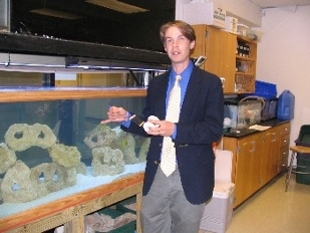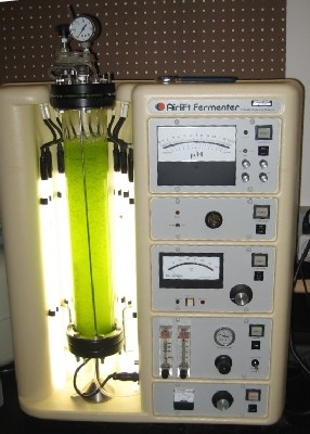Microscopic Plant Has Researchers Thinking Big:Algae Oil Seen as Viable Alternative to Petroleum
NewsBy Eric Gorton, JMU Media Relations

The machine looks interesting enough to the casual observer. A glass cylinder filled with bubbling water sits on the left, brilliantly illuminated by six flourescent light bulbs. There are some buttons and gauges on a panel to the right of the cylinder and a hose links the contraption to a carbon-dioxide tank a few feet away.
Chris Bachmann, assistant professor of integrated science and technology, and his students would be much happier with the machine — a bioreactor, to be more precise — if that cylinder was so full of green algae that it blocked the light.
If all goes well, that's how it will look by the end of the academic year, when James Madison University seniors Ryan Geary, Andrew Flatness, John Kauffman and Billy Broas are ready to present their senior thesis project at the annual College of Integrated Science and Technology Senior Symposium. By late April, they hope they will be able to discuss the finer points of successful algae cultivation, at least in a controlled environment.
But the project is about so much more than growing algae. Years of research by the federal government, other universities and even private companies have proven algae to be a good source of oil, oil that can be used to produce biodiesel, a clean-burning alternative to petroleum diesel.
The emphasis of algae-biodiesel research these days is on finding which species of the fast-growing microscopic plants produce the most oil, discovering ways to make them produce even more and learning the best ways to grow them.
From 1978 to 1996, the U.S. Department of Energy’s Office of Fuels Development funded a program to develop renewable transportation fuels from algae. The project involved producing biodiesel from high-lipid content algae grown in ponds, utilizing waste carbon dioxide from coal-fired power plants. The research concluded that algal biodiesel is one of the only avenues available for producing biofuels while also absorbing carbon dioxide generated in power plants — marrying the electric utility industry's need for carbon disposal with the need for clean-burning alternatives to petroleum in transportation. The open-pond system was less than ideal, however, being subject to such issues as temperature fluctuations, evaporation and contamination.

Closed-loop bioreactors that simultaneously reduce industrial exhaust gas emission and produce high-value biomass feedstock for producing biodiesel are being developed, and there is much interest in identifying specific types of algae to produce the highest yields.
Thus, Bachmann and his students are busy designing tests for 15 algae strains, 12 more than they had last year at the start of the ISAT aquatic species program. Many of the tests will be conducted in the bioreactor and a controlled environmental chamber, where carbon-dioxide levels can be manipulated, where nutrients can be evaluated, where the water temperature can be adjusted and where acidity levels can be altered — all in hopes of finding the perfect growing conditions.
"As long as it has the right nutrients, water, CO2 and sunlight, or grow light, then they'll grow," Bachmann said. "And these algae grow very quickly, with each individual algae cell dividing into two daughter cells. They double every time they divide, so if you start with one, you'll get two; then four, then eight, then 16, then 32, until eventually you have millions and millions more algae with each division. Once you get cultivation up to a critical mass, you can pull out large quantities of algae at the same rate at which they are growing, providing a continuous source of biomass for fuel production."
It's those quick-growing qualities and high-oil content that make algae such ideal candidates for producing biodiesel, even better than other oil crops of much larger stature, such as soybeans, sunflowers, oil palms and peanuts, all of which require much more growing space and which yield much less oil per acre.
"Most of these plants concentrate their oil within their seeds, which are produced only during a specific part of the plant's life cycle," Bachmann said. "These seeds represent only a small fraction of the plant's overall mass. With algae, you are not limited to a specific harvest period, and you are utilizing the entire plant, which may be up to 50 percent oil (compared to soybeans, which contain about 20 percent oil by weight). So high oil and fast growth rate means potential for more fuel."
Algae Farms at Sea
In addition to using the bioreactor, Bachmann and his students are experimenting with growing algae in a saltwater fish tank.
"One of the things that we want to look at is whether or not these algae could be cultivated offshore, to save valuable land area needed for housing and current food production practices," Bachmann said. "But, in order to do this, you must ensure you can do it in a contained manner, so that the algae do not disrupt the environment.
"Offshore algae farms have the potential to absorb significant amounts of CO2 and produce substantial amounts of bio-oil. But algae plumes could alter entire ecosystems if they cannot be properly contained, and you do not want that happening."
The Chesapeake Bay is a testament to this, Bachmann said. The bay has struggled with algae problems in the past, and felt strains on the fishing industry there. In certain conditions, fertilizer runoff can lead to large-scale algae plumes so thick, they block sunlight from getting through to organisms below the surface that need it. In severe conditions, those organisms die off, thus disrupting the food chain.
"These algae plumes can be quite large, some more than 400 miles in length," Bachmann said. "Right now, no one wants to clean them up. But if companies could harvest these microalgae and process them into fuel, then they just might just be motivated enough to help cleanup this environmental problem."
The deep ocean, far offshore, could prove to be an ideal place for cultivating algae without disrupting the environment.
"A lot of the ocean — 95 percent of it or so — is really like a barren desert and it doesn't have anything growing in it," Bachmann said. "As you travel into the open ocean, the surface of the sea is too far away from the nutrients that are found in the soil. These nutrients are essential for plant growth. If you're at the shore, the nutrients are here, the sunlight's here, everything grows. If you go into the deeper ocean, the sunlight is still present, but the nutrients are far below the surface and nothing will grow."
The fish tank trials will provide answers to a couple of questions: Are there algae that will grow there and can it be contained? In an attempt to keep the algae from spreading, it will be grown in clear dialysis tubing. "So if we could load up a tube, bright green, filled with algae, put it in there, have it keep growing and not have our tank get overrun with it, then we're looking pretty good," Bachmann said.
As for the nutrient source, poultry litter might do quite nicely, he said.
Grow Algae, Clean the Air

Growing algae in contained systems fed with carbon dioxide is another important part of the ISAT research. Like all photosynthetic plants that get their energy from the sun, algae pulls carbon dioxide out of the air.
The U.S. Department of Energy pumped carbon-dioxide emissions from coal-burning factories into its algae ponds, and GreenFuel Technologies Corp., based in Cambridge, Mass., worked with the Massachusetts Institute of Technology to develop a prototype system that can be mounted on factories to make use of carbon-dioxide emissions.
"It's really neat technology," said Bachmann, adding that such a unit potentially could be mounted atop Harrisonburg's trash incinerator. "Right now for every three trucks of trash that go into that facility, only one truckload of waste comes out, reducing what goes to the landfill by a factor of three. And, the energy liberated from the burning trash is then used to provide heat, electricity and air conditioning to the JMU campus. It's really quite a marvelous facility, but they're still throwing CO2 up into the atmosphere. With this technology, they could harness a lot of that CO2 to make a renewable biofuel, while using the electricity and the heat generated from the burning trash to power it. So you're really not putting energy in, you're putting trash in and you're getting a valuable resource out."
Under the right conditions, Bachmann is confident algae and other aquatic species can provide enough biodiesel and ethanol to have a noticeable effect on the amount of oil the United States imports from other countries.
"If it works very well, and if all of these industries that are putting out CO2 had those units installed on their factories, and if you cultivate algae on a larger scale offshore, then you have potential to address the inevitable loss of oil," he said. "This is especially true when this technology is coupled with another emerging biofuel processing strategy known as cellulose digestion."
Cellulose is one of the main components of plants and represents the Earth's most abundant organic compound, Bachmann said. Composed of simple sugars connected together in long chains, cellulose can be used as a feedstock for ethanol production. Advanced bioethanol technology allows fuel ethanol to be made from any plant fiber, such as corn stalks, scrap wood, sawdust, wastepaper, cardboard, wood, leaves and grass clippings. It requires about a third of the net energy input per gallon compared to traditional ethanol, he said, and when blended with gasoline at 85 percent, it reduces greenhouse gas emissions up to 90 percent.
"After the oil has been extracted from the algae, what you have left is largely cellulose," Bachmann said. "Enzymatic digestion of cellulose presents an environmentally sound alternative for the economical production of large quantities of renewable biofuel. When developments in biotechnology that improve cellulase-enzyme production and utilization are coupled with the next generation of fast-growing biomass feedstocks, like microalgae, you have the potential to relieve a significant portion of the impending energy crisis."

